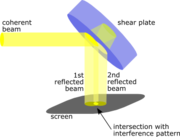
Shearing Interferometer
Encyclopedia

Laser
A laser is a device that emits light through a process of optical amplification based on the stimulated emission of photons. The term "laser" originated as an acronym for Light Amplification by Stimulated Emission of Radiation...
sources which have a coherence length
Coherence length
In physics, coherence length is the propagation distance from a coherent source to a point where an electromagnetic wave maintains a specified degree of coherence. The significance is that interference will be strong within a coherence length of the source, but not beyond it...
which is usually a lot longer than the thickness of the shear plate (see graphics) so that the basic condition for interference is fulfilled.
Function
The testing device consists of a high quality optical glass (like BK-7) with extremely flat optical surfaces and usually having a slight angle between them. When a plane wave is incident at an angle of 45° (which gives maximum sensitivity) it is reflected two times. The two reflections are laterally separated due to the finite thickness of the plate and by the wedge. This separation is referred to as the shear and has given the instrument its name. The shear can also be produced by gratings, see External Links below.Parallel-sided shear plates are sometimes used but the interpretation of the interference fringes of wedged plates is relatively easy and straightforward. Those wedged shear plates produce a graded path difference between the front and back surface reflections. As a consequence, a parallel beam of light produces a linear fringe pattern within the overlap.
With a plane wavefront incident, the overlap of the two reflected beams shows interference fringes with a spacing of
 , with
, with  being the wavelength
being the wavelengthWavelength
In physics, the wavelength of a sinusoidal wave is the spatial period of the wave—the distance over which the wave's shape repeats.It is usually determined by considering the distance between consecutive corresponding points of the same phase, such as crests, troughs, or zero crossings, and is a...
of the beam, n being the refractive index
Refractive index
In optics the refractive index or index of refraction of a substance or medium is a measure of the speed of light in that medium. It is expressed as a ratio of the speed of light in vacuum relative to that in the considered medium....
and
 the wedge angle. The fringes are equally spaced and will be exactly perpendicular to the wedge orientation and parallel to a usually present wire cursor aligned along the beam axis in the shearing interferometer. The orientation of the fringes varies (i.e. they are tilted on the screen) when the beam is not perfectly collimated but diverging or converging. In the latter case of a noncollimated beam (thus having a curved wavefront) is incident on a wedged shear plate the path difference between the two reflected wavefronts is increased or decreased from the case of perfect collimation, depending on the sign of the curvature. The pattern is then rotated and the beam's wavefront radius of curvature
the wedge angle. The fringes are equally spaced and will be exactly perpendicular to the wedge orientation and parallel to a usually present wire cursor aligned along the beam axis in the shearing interferometer. The orientation of the fringes varies (i.e. they are tilted on the screen) when the beam is not perfectly collimated but diverging or converging. In the latter case of a noncollimated beam (thus having a curved wavefront) is incident on a wedged shear plate the path difference between the two reflected wavefronts is increased or decreased from the case of perfect collimation, depending on the sign of the curvature. The pattern is then rotated and the beam's wavefront radius of curvature  can be calculated:
can be calculated:  , with
, with  the shear distance,
the shear distance,  the fringe distance,
the fringe distance,  the wavelength and
the wavelength and  the angular deviation of the fringe alignment from that of perfect collimation.
the angular deviation of the fringe alignment from that of perfect collimation.

